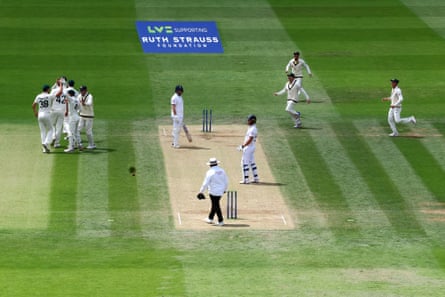The culture of English cricket is but one concept of morality – no person, and certainly no country, has a monopoly on virtue writes Jonathan Liew in The Guardian
So let’s talk about Nepal v Ireland in the Oman Quadrangular Twenty20 series last year. Ireland are 114 for eight in the 19th over when the ball is hit towards mid-on. The Oman bowler Kamal Singh lunges at it in his follow-through. At the same time the Ireland non-striker, Andy McBrine, tries to scamper through for a single. The pair collide. McBrine falls over. Singh keeps his balance, and tosses the ball to the wicketkeeper Aasif Sheikh, with the batter still sprawled on the turf, miles out of his ground.
The laws of cricket have nothing to say on situations such as this. Neither player is deliberately obstructing the other; neither player can avoid the collision without giving up a significant sporting advantage. Sheikh is perfectly at liberty to complete the run-out. But he does not. He holds on to the ball and lets McBrine complete the single, an act of sporting goodwill that will later earn him the International Cricket Council’s Spirit of Cricket award.
Yes, here we go again: a think-piece about the current Ashes series that has very little to do with the current Ashes series. One of the reasons the dismissal of Jonny Bairstow by Alex Carey on Sunday has created so much noise is because it is one of those issues where no expertise whatsoever is required to express an opinion. Anyone can participate in this game: Rishi Sunak, Sue off Twitter, Jeremy Vine, your best mate who doesn’t really know anything about cricket but thinks Josh Tongue is a funny name. Let’s fulminate. Let’s pontificate. Let’s play.

At which point we run into the minor inconvenience of Law 20.1.2, which is basically unequivocal on the point that Bairstow was out. Nobody really seems to dispute this, or even have a workable alternative to the law as it stands. What, then, is everyone arguing about? Ultimately, it comes down to ownership and territory and narrative and culture: who gets to define cricket, and in whose benefit they do so. And thus it is again – with deepest apologies – necessary once again to discuss Bazball.
There is a common thread running through England’s new vibes-based style of cricket and the piqued outrage that has greeted Bairstow’s stumping. Both, ultimately, are grounded in an idea of impunity and presumption: an assertion that England and England alone gets to adjudicate on what is good for the game. We get to say what constitutes entertainment. We get to decide how Test cricket must be saved. And, by extension, we get to judge what is sporting and fair, the norms of behaviour that our opponents will be expected to follow. You can keep your silly rules. We stand for more.
Of course, England is by no means alone in its sense of exceptionalism. Australia has long declared itself the moral arbiter of where “the line” stands in terms of sledging. India creates most of the sport’s revenue, and before long it will probably conclude that it should be creating most of the sport’s morality as well. The through-line here is power: the power to generate headlines, to set an agenda, to establish norms and impose them on others. In a sport as ritualistic as cricket, governed as much by tacit understandings and shared assumptions as written laws, this kind of soft power allows those with a platform to build an ethical framework around their own values and priorities.

Is it outlandish to posit that the reason Bairstow strayed out of his ground was because he had internalised a mindset in which rules were optional and the vibe was the thing? Feels like the end of the over? Hell, assume it probably is. The dismissal felt wrong to me, and it may well have felt wrong to you too. But then we have all been steeped in the culture of English cricket, with all its inherent flaws and biases and blind spots. It is but one concept of sporting morality, and it is probably about time we recognised there were others.
The real shame here is that so much of the discourse either falls along tribal lines or is couched in pointless terms such as “spirit of cricket”. Perhaps we need an alternative vocabulary here: what is unsatisfyingly described as the “spirit of cricket” is so often just a kind of basic empathy, a politeness, a willingness to treat others as one would wish to be treated. There is common ground to be found here, a recognition that there are parts of every sport that rules cannot delineate, because humans are complex and life is messy and the best sports express the very fullest of both.
Let Carey be judged on his own free will, just as Sheikh was when he refused to rugn out McBrine. But you will also need to know that after Ireland’s reprieve McBrine hit the next ball for six, the last two wickets put on 13 runs and Ireland won a tight low-scoring game. Sheikh’s conscience may have been clear. But his team probably ended up bottom of the table as a result. “It would have been unfair to the opponent,” he said later. “We wouldn’t be pleased if our team had got the wicket in that manner, since it would be against our culture.”
Let us have a conversation about what cricket’s shared values should really be, and let those with the smallest platforms speak first. Let us recognise that no person, and certainly no country, has a monopoly on virtue. Let us fulminate. Let us pontificate. This is, after all, everyone’s game, and everyone can play.


